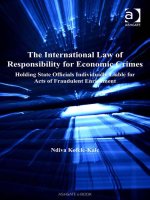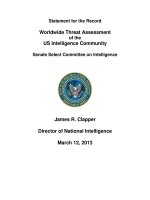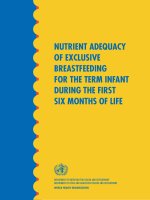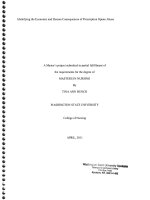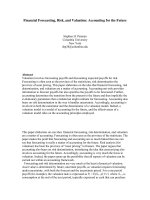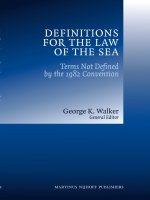Definitions for the Law of the Sea potx
Bạn đang xem bản rút gọn của tài liệu. Xem và tải ngay bản đầy đủ của tài liệu tại đây (1.32 MB, 354 trang )
Denitions for the Law of the Sea
Report of the
International Law Association
American Branch
Law of the Sea Committee
Martin H. Belsky,
William Burns,
John King Gamble,
Gunther F. Handl,
Andrew J. Jacovides,
Coalter G. Lathrop,
Margaret M. Mahoney,
Dennis L. Mandsager,
John Morgan,
Allison Morris,
John E. Noyes,
Michael W. Reed,
J. Ashley Roach,
Davis Robinson,
Howard S. Schiman,
Kelly Swanston,
John Temple Swing,
Richard M. J. urston,
Elaine Vullmahn,
Reid E. Whitlock,
Members
George K. Walker, Chair
2012
Denitions for the Law of the Sea
Terms Not Dened by the 1982 Convention
General Editor
George K. Walker
is book is printed on acid-free paper.
Library of Congress Cataloging-in-Publication Data
Denitions for the law of the sea : terms not dened by the 1982 Convention / general editor,
George K. Walker.
p. cm.
ISBN 978-90-04-21160-5 (hardback : alk. paper) 1. Law of the sea Dictionaries. I. Walker,
George K., 1938-
KZA1125.D44 2012
341.4’503 dc23
2011034842
ISBN 978-90-04-21160-5
Copyright 2012 International Law Association, American Branch.
Koninklijke Brill NV, Leiden, e Netherlands.
IDC Publishers, Martinus Nijho Publishers and VSP.
All rights reserved. No part of this publication may be reproduced, translated, stored in
a retrieval system, or transmitted in any form or by any means, electronic, mechanical,
photocopying, recording or otherwise, without prior written permission from the publisher.
Authorization to photocopy items for internal or personal use is granted by KoninklijkeBrillNV
provided that the appropriate fees are paid directly to e Copyright Clearance Center,
222 Rosewood Drive, Suite 910, Danvers, MA 01923, USA.
Fees are subject to change.
Foreword
xiii
I.
I
ntroduction to the Report
1
A.
F
ormat of the Report; Rationale for and Uses of
the Report
2
B
.
P
rojections for the Future
5
C.
N
otes of anks
6
II.
T
able of Abbreviated (Short) Citations and Terms;
Conventions for Citations
9
III.
C
ommentaries on Formulating Denitions for the 1982
Law of the Sea Convention
19
A.
P
lan and Progression of the Project, George K. Walker
21
B
. Sources of Law, the 1982 Law of the Sea Convention,
George K. Walker
25
C.
e Role and Relationship of Understandings,
Declarations and Statements, also Collectively
Known as Interpretative or Interpretive Statements,
Appended to the 1982 Law of the Sea Convention and
George K. Walker
37
D
.
I
nterpreting the 1982 Law of the Sea Convention and
Dening its Terms, John E. Noyes
45
1.
T
reaty Interpretation and Denitions of
Treaty Terms
45
2.
D
enitions in the Law of the Sea Convention
51
a.
“Mile”
52
b
.
D
enitions Relating to the Continental Shelf
53
c.
“
Ship” or “Vessel”
55
62
e
. “Genuine Link”
69
3.
Conclusion
78
E.
“Words! Words! Words!”: Dilemmas in Denitions,
George K. Walker
79
vi
IV.
D
enitions for the Law of the Sea: Terms Not Dened by
the 1982 Convention
85
85
B
.
D
enitions for the 1982 Law of the Sea Convention
86
§
1. Accuracy
86
§ 2
A
djacent coasts
86
§ 3.
A
id(s) to Navigation; Navigational Aid(s);
Facility (Navigational)
89
§
4. Alarm
92
§ 5.
Applicable and Generally Accepted 92
§ 6.
A
ppropriate; appropriation
97
§ 7.
A
ppropriate international organization or
appropriate international organizations
99
§ 8.
A
ppropriate notice
103
§ 9.
A
rea and area
103
§ 10.
A
rticial island, oshore installation, installation
(oshore)
104
§ 11.
A
ssociated species or dependent species
107
§
12. Atoll
109
§
13. Attributes
111
§
14. Azimuth 111
§ 15.
B
ank; bank(s)
112
§ 16.
B
asepoint or point
113
§ 17.
B
earing, abbreviated BRG
121
§
18. Bed
122
§ 19.
B
enet of mankind as a whole, or benet of
humankind as a whole
122
§ 20.
B
lack box
124
§
21. BRG
124
§
22. Cap
124
§ 23.
C
hart; nautical chart
126
§ 24.
C
hart datum
128
§ 25.
C
hart symbol
129
§ 26.
C
losing line
129
§
27. CMG
130
§
28. Coast
130
§ 29.
C
oast Pilot
131
§ 30.
Coastal Pilots 131
§ 31.
Coastal State 131
§ 32.
C
oastal warning
134
vii
134
§ 34.
C
ommon heritage of mankind or common
heritage of humankind
134
§ 35.
C
ompetent international organization or
competent international organizations
137
§
36. Compilation
149
§ 37.
C
ontinental rise
150
§ 38.
C
ontinental slope
152
§ 39.
C
ontributions in kind
154
§
40. Coordinates 158
§
41. Course
158
§ 42.
C
ourse made good, abbreviated as CMG
158
159
§ 44.
D
anger to navigation
159
§ 45.
D
anger to overight
161
§ 46.
D
atum (vertical) or vertical datum
163
§ 47.
D
eep ocean oor
163
§
48. Delimitation
164
§
49. Delta
164
§ 50.
D
ependent species
165
§ 51.
Developing State(s) 165
§
52. Distress
169
§ 53.
Dr
ying reef
175
§ 54.
D
ue notice, appropriate publicity, and due
publicity
176
§ 55.
D
ue publicity
179
§ 56.
Due regard 179
§
57. Entity
188
§ 58.
E
quidistance line; equidistant line; median line
188
§ 59.
E
quidistant line
189
§
60. Estuary
189
§ 61.
F
acility (Navigational)
191
§ 62.
F
acility (Port)
191
§
63. Feature
191
§ 64.
F
eature object
191
§
65. Fishing
192
§ 66.
Fl
ag state
193
§ 67.
Foot of the continental slope 196
§ 68.
Force majeure 197
§ 69.
F
ringing reef
205
viii
§ 70. Generalization
206
§ 71.
G
enerally accepted
206
§ 72.
G
enuine link
206
§ 73.
G
eo object
210
§ 74.
G
eodetic data
210
§ 75.
G
eodetic datum
211
§ 76.
G
eographic coordinates, geographical
coordinates, or coordinates
213
§ 77.
G
eographical coordinates
215
§ 78.
Geometric primitive 215
§ 79.
H
arbor works; facility (port)
216
§
80. Heading
217
§ 81.
H
igh seas
218
§ 82.
H
istoric bay
225
§ 83.
H
ydrographic survey
227
§
84. Indicator
229
§ 85.
I
nstallation (oshore)
230
§ 86.
I
nternational nautical mile
230
§
87. Isobath
230
§ 88.
L
and domain
231
§ 89.
Land territory; land domain 231
§ 90.
L
atitude, parallels of latitude or parallels
233
§
91. Leg
234
§ 92.
L
ight list
235
§
93. Line
235
§ 94.
L
ine of delimitation
235
§ 95.
List of lights or light list 237
§ 96.
L
ist of Radio Signals
237
§ 97.
L
ongitude; meridian or meridians
238
§ 98.
L
ow water line or low water mark
239
§ 99.
L
ow water mark
241
§ 100.
M
arine scientic research, abbreviated MSR
241
§ 101.
M
aritime safety information, abbreviated MSI
245
§ 102.
M
aximum sustainable yield
245
§ 103.
M
edian line
247
§ 104.
M
eridian or meridians
247
§ 105.
M
ile or nautical mile
247
§ 106.
Monetary penalties only; monetary penalties 249
§ 107.
Mouth (of a bay) 251
§ 108.
M
outh (of a river)
252
ix
§ 109. MSI
253
§
110. MSR
253
§ 111.
N
atural prolongation
253
§ 112.
N
atural resources
254
§ 113.
N
autical chart
257
§ 114.
N
autical mile
257
§
115. Navarea
257
§ 116.
N
avarea warning
258
§ 117.
N
avigational aid(s)
258
§ 118.
Navigational warning 258
259
§
120. Notice
259
259
§ 122.
N
otice to mariners, abbreviated NtM
260
260
§
124. NtM
261
261
261
263
264
265
265
266
267
272
275
§ 135.
P
arallels of latitude or parallels
276
§
136. Point
276
§
137. Port
276
§
138. Precision
279
§
139. Presentation
279
§
140. Reef
279
§ 141.
R
egional organization or subregional
organization
280
§
142. Rise
282
§
143. River
282
§
144. Road 284
§
145. Roads 284
§ 146.
R
oadstead or roads
284
x
§ 147. Rock
286
§
148. Route
287
§ 149.
R
oute planning
287
§ 150.
R
outing system, also spelled routeing system
288
§ 151.
R
ules of the Nautical Road
289
§ 152.
R
ules of the Road, or Rules of the Nautical Road
289
§ 153.
Sa
iling directions, Coast Pilot or Coastal Pilot
290
§
154. Scale
291
§ 155.
S
cale bar
292
§
156. Sea 293
§ 157.
S
ea-bed, seabed or bed
293
§
158. Seabed
294
§ 159.
S
eaworthy; seaworthiness
294
§ 160.
S
edimentary rock
295
§ 161.
S
erious act of pollution
297
§
162. Shelf
298
§ 163.
S
hip or vessel
300
§
164. Slope
301
§
165. SMG
302
302
302
§ 168.
S
patial object
302
§
169. Speed
302
§ 170.
S
peed made good, abbreviated SMG
303
303
304
§
173. Spur 305
§ 174.
S
traight archipelagic baseline
306
§ 175.
S
traight baseline
306
§ 176.
S
traight line; straight baseline; straight
archipelagic baseline
306
§ 177.
S
trait; straits
308
§
178. Straits
310
§ 179.
S
ubmarine cable
310
§ 180.
S
ubmarine elevation
312
§ 181.
S
ubmarine pipeline
313
§ 182.
S
ubmarine ridge
315
§ 183.
Subregional organization 317
§
184. Subsoil 317
§ 185.
S
uperjacent waters, or water column
319
xi
§ 186.
S
upplementary information
320
322
§
188. alweg
323
§
189. Tide
324
§
190. Track
325
§ 191.
T
rack keeping
325
326
§ 193.
T
rue distance
328
§
194. Vector
329
§ 195.
Vertical datum 329
§
196. Vessel
329
§ 197.
V
oyage data recorder, sometimes referred to
as a “black box.”
329
§ 198.
V
oyage plan
330
§
199. Warning
331
§ 200.
W
ater column
332
§
201. Waypoint
332
V
.
Conclusions
335
1
John Norton Moore is the Walter L. Brown Professor of Law at the University of
National Security Law. Formerly he served as a United States Ambassador for the Law
of the Sea Negotiations, Deputy Special Representative of the President for the Law of
the Sea Negotiations, and Chairman of the National Security Council Interagency
Government. Subsequently he served as a member of the National Advisory
Marine Technology Society, and was a founding director of the Rhodes Academy of
the Department of State and as the rst Chairman of the Board of the United States
Institute of Peace.
J
ohn Norton Moore
1
one of the most important multilateral conventions in history. Adopted
in 1982, and eectively completed in 1994 with a revision of Part XI on
Deep Seabed Mining, the Convention is today in force for 160 nations
plus the European Union. In its 17 parts encompassing 320 articles
with nine annexes (and Final Act with six annexes) the Convention is
quarter century in the making, the Convention has achieved a remark-
able breakthrough in oceans law ending the struggle lasting more than
four centuries between coastal nations seeking expanded control over
coastal resources and maritime powers seeking to protect navigational
freedom so essential for global trade and commerce. e answer
embodied in the Convention is a simple functional division of ocean
space, with coastal nations given jurisdiction over an extended 200
nautical mile exclusive economic zone for sheries and other eco-
nomic interests while navigation remains a high seas freedom beyond
the territorial sea. In so doing the Convention has implemented the
community common interest on both issues and has achieved a true
win/win situation. Further, the Convention strengthens navigational
rights through modernization of the regime of innocent passage as
embodied in the 1958 Geneva Conventions and adopts an important
new regime of transit passage for international straits. In addition, the
xiv
Convention embodies an impressive framework environmental regime
for the oceans, modernizes the regimes for the continental margin
(still termed “continental shelf”) and marine scientic research.
Following the 1994 revision, it sets out a workable regime for deep
seabed mining in areas beyond national jurisdiction. e Convention
also creates an eective dispute resolution mechanism, oering a
choice between the International Court of Justice, a new Law of the Sea
United Nations Charter, the Vienna Convention on the Law of Treaties,
and the 1949 Geneva Conventions on the Law of War, as among the
most important and successful multilateral international agreements
in history.
Commentary
2
prepared with broad international participation under
Policy. Virginia also maintains one of the largest collections of oceans
law materials in the world, as well as what is believed to be the only
oceans law archive in the world.
Denitions for the Law of the Sea, reecting the work of the
International Law Association (American Branch) Law of the Sea
Committee in providing denitions for over 200 terms not dened
the Virginia Commentary. It has been prepared with the participation
of many top experts in oceans law, including important oceans law
scholars from around the world and submission for comment to the
Particular thanks for this outstanding book are due J. Ashley Roach
who, as the then top expert in oceans law of the United States
Department of State, initially suggested the project, and the Chair of
the International Law Association (American Branch) Law of the Sea
Committee, Professor George K. Walker, who as Committee Chair
undertook the work of compiling the volume, an enormously time
consuming task normally undertaken by a committee reporter.
Professor Walker, as a former Stockton Professor of International Law,
2
United Nations Convention on the Law of the Sea 1982: A Commentary, vols. 1–7
(Myron H. Nordquist editor-in-chief).
xv
3
e Master of Laws program at the University of Virginia School of Law, as at all
American law schools, is eectively a post-doctoral program in law, as today the rst
degree in law, the Juris Doctor degree, is itself a doctorate. Retention of the degrees
Master of Laws (LL.M.) and Doctor of Jurisprudence (J.S.D. or S.J.D.) for the post-
doctoral programs in American law is an artifact of the time when the rst degree in
law was called a Bachelor of Laws (LL.B.).
is widely regarded as one of the top experts in the law of the sea. is
work certainly conrms that reputation. e law of the sea community
owes him a debt of gratitude for this important work.
ere is yet another reason why it is a special pleasure for me to
recognize this important new contribution to law of the sea scholar-
ship and the outstanding work of Professor Walker. For Professor
Walker, the force behind this splendid addition to the law of the
sea, was one of the outstanding Master of Laws
3
graduates of the
University of Virginia School of Law. It was my pleasure to admit
Professor Walker to the program and to have him as a student during
my tenure as Director of the Graduate Program at Virginia. As such,
I have long admired Professor Walker’s scholarship and appreciated
his friendship.
CHAPTER I
INTRODUCTION TO THE REPORT
4
In 2001 the International Law Association, American Branch, Law of
the Sea Committee began its project of dening terms in the 1982 UN
Convention on the Law of the Sea
5
or in UNCLOS analysis for which
this treaty does not supply denitions. J.
As
hley R
o
ach, a longstanding
Committee member, suggested the project to the Committee chair and
submitted some of the rst terms for analysis.
As a
n experiment, the Committee chair decided to undertake the
project without a reporter. Committee membership has been small in
number, from 10 to 22; the thought was that the chair could commu-
nicate directly with members and prepare dras for direct considera-
tion by them.
A
er preparing
Ten
tative
D
ras and a
Re
vised
Ten
tative
D
ra on
one occasion, the chair submitted them to Committee members for
comment. e chair particularly recognizes the strong support,
detailed comments and suggestions of Committee members John
E.
No
yes and H
o
ward S. Schiman. A
lex G.
O
ude
E
lf
erink of the
Net
herlands Institute for the Law of the Sea and the U
ni
versity
of
U
t
recht was also most helpful in providing comments and sugges-
tions for denitions.
Dr. Ibne H
a
ssan made detailed comments on
many terms.
e chair also sent copies of Committee research dras to others in
the
U
ni
ted States and around the world, including the Division for
4
Part I begins the Report as published in 2009–10 ABILA Proc., where it was pub-
lished as
Pa
rt I.
Pa
rt I is identical with its
Pr
oceedings counterpart except for the
General E
di
tor’s adding the name of his current secretary, Brenda Sargent, in P
a
rt I.3,
and renumbered footnotes. e rest of the book is identical with the 2009–10 ABIL
A
Pr
oc. version except P
a
rts III.A and P
a
rt III.D
.
P
a
rt III.A was edited to remove dupli-
cate material discussed in P
a
rt I.1 at the request of the publisher, to add updated mate-
rial, and to publish the
A
BIL
A
L
O
S Committee’s unanimous resolution, 2009
Resolution Supporting U.S. Accession to the Law of the Sea Convention, 2009–10 ABIL
A
Pr
oc. 541, voted aer Committee approval of the
Rep
ort. John N
o
yes submitted a
revised P
a
rt III.D to combine P
a
rts III.D and III.E of the
Rep
ort and to conserve pages.
Pa
rt III.E is the R
ep
ort’s P
a
rt III.F with no amendments other than renumbered
footnotes.
5
Abbreviated as UNCLOS in this Report. See Part II, Table of Abbreviated (Short)
Citations and Terms; Conventions for Citations.
2
6
e Journal gave reprint publication for extracts from or republication of these
copyrighted articles, whose full titles are given in P
a
rt II: Walker & N
o
yes, Denitions;
Walker &
No
yes, Denitions II; Walker, Dening; Walker, Last Round.
Pa
rts III and IV
republish them, in whole or in part, sometimes in amended format, e.g., for more cur-
rent citations. e chair also published Filling Some of the Gaps: e International Law
Association (American Branch) Law of the Sea Denitions Project, 32 Fordham Int’l L.J.
1336 (2009), describing the project, in an issue honoring P
r
ofessor Joseph C. Sweeney,
his longtime friend and colleague.
7
See note 5 and accompanying text.
Ocean Aairs and the Law of the Sea of the UN Oce of Legal Aairs
for comment and expresses appreciation for comments received from
these sources.
D
ras also appeared in the Proceedings of the
Am
erican
Branch and in articles published in the California Western International
Law Journal available in print and on line format.
6
Other reviews,
e.g., the Journal of Maritime Law & Commerce, noted the California
Western Journal articles. e work of the Committee also went to the
Am
erican Branch
D
irectors of
Res
earch and P
r
esidents of the
Am
erican Branch. e Committee chair mailed California Western
Journal oprints to colleagues in the
Uni
ted States and around the
world, inviting comment.
e Committee sponsored panel discussions at
Am
erican Branch
annual fall meetings. Besides communications from Committee mem-
bers, these discussions produced useful suggestions for revisions and
additional terms for research and analysis.
e Committee has reviewed and commented on this dra, which
was published in the 2009–10
ABIL
A
Proceedings.
A
.
F
R
;
R
U
R
Pa
rt II lists abbreviated citation forms and terms commonly used
throughout this Report.
P
a
rt III reprints previously-published articles,
in whole or in part, on the project with updated citations.
7
Part IV
recites denitions for terms the Convention does not dene and terms
for use with UN
CLO
S analysis with Comments for each denition; it is
the heart of this Report. P
a
rt V oers general conclusions.
ere are several reasons for and uses of the Report. A
s i
ts title sug-
gests, it attempts to provide meanings for words and phrases in
UNCLO
S for which the Convention does not give denitions, and
denitions for terms used in Convention analysis. e Report attempts
to consolidate and publish denitions for these terms aer research in
3
8
E.g., the Former Glossary, partly published in Annex A1–5 to NWP 1–14M
Ann
otated, which is itself under revision. e fourth edition of the Consolidated
Glossary is thus far available only on line. See P
a
rt II for full citations to these sources.
9
E.g., some terms in the Consolidated Glossary.
10
ICJ Statute arts. 38, 59; Restatement (ird) §§ 102–03; Churchill & Lowe 5–27;
Jennings & Watts §§ 8–16.
several sources, some of which are on line and some are in print,
perhaps in less than accessible books. Some sources may be out of date
although in print or on line.
8
As Part III.A emphasizes, the Committee
has not sought to rewrite
UNCLO
S by redening terms for which the
Convention supplies meanings. Some glossaries have done so.
9
e
result for a less than careful user of the latter sources is that they can
lead a researcher to apply UN
CLO
S-dened words or phrases in a way
that is incompatible with the Convention. For all denitions in this
Report, the Committee has endeavored to publish a denition that is
oriented toward UN
CLO
S and not a geographic or geological deni-
tion; these may be similar but not identical.
As
P
a
rts III.B and III.C emphasize, this Report’s product is at best a
secondary source, or perhaps a source that aids in determining and
giving content to primary sources like custom, treaties (including
interpretive statements appended to UN
CLO
S) and general principles
of law.
10
e denitions can be a counterweight or support to the
research from other, similar secondary sources. Where there is no
other source, the Report may be the only source; it is hoped that the
wide distribution of the work of the Committee, through publication
in the ABIL
A
Proceedings and the California Western International
Law Journal, oprint distribution and discussion and correspondence
has broadened the Committee’s resources beyond its membership.
e published discussion of the context of the project, reprinted in
Pa
rts III.C-III.E, cautions UN
CLO
S researchers; this Report is not the
end of the story. For example, the
UN
CLO
S Commission on the Limits
of the Continental Shelf and the IL
A
Committee on the O
u
ter Limits
of the Continental Shelf have supplied and will supply context in the
future for
UN
CLO
S terms. A new IL
A
Committee on baselines may
also supply future context.
e Report has served, and hopefully will continue to serve, as a
platform for discussion among those who research
UN
CLO
S and
those, including governments, who as oceans users are governed or
guided by
UN
CLO
S. P
a
rt III.A emphasizes that this Report does not
represent the views of any government or government department,
4
the IL
A
or the ABIL
A
. Committee members who are or have been in
government service spoke, corresponded or wrote did so in their pri-
vate capacities. eir views are their personal opinions and are not to
be considered as the views of the governments they serve or have
served.
Pa
rt IV, the denitions portion of the Report, follows this general
format:
1.
S
tatement of a term preceded by a section number for ease of cita-
tion and perhaps followed by appositive or similar terms;
2.
A Comment with these parts:
a.
A statement that the law of armed conict (L
O
A
C); l
aw devel-
oped under the
UN Charter through, e.g., UN Security Council
decisions under
UN Charter A
r
ticles 25, 48 or 94; or jus cogens
norms may result in a dierent denition;
b.
e source(s) for the term;
c.
Discussion of the term as it appears in UN
CLO
S and the 1958
L
O
S Conventions;
d.
Cr
oss-references to other related terms in the Report;
e.
Ci
tation to general primary and secondary authorities, including
previously-published research.
Where a term has appositive words or abbreviations, those appear in
separate sections, with reference to the section with discussion and
analysis.
A researcher seeking meaning of a word or phrase may con-
sult the
T
a
ble of Contents and proceed directly to analysis, whether
that researcher has an abbreviation or appositive term or the analyzed
term. ere is no index for the Report.
Pa
rt IV also attempts to place denitions in broader contexts of
international law.
First, it is axiomatic that Security Council decisions (a term of art
distinguishing them from Council recommendations and the like)
trump treaties through a combination of
UN Charter A
r
ticles 25, 48,
94 and 103.
T
o b
e sure, thus far the Council has usually spoken in gen-
eral terms in its resolutions, but applying Charter-based law might
come in implementing actions, e.g., peacemaking or peacekeeping
operations or agreements under a general Council mandate.
P
a
rts III.B
and III.C should also be consulted.
Second, applying the L
OAC may result in a dierent denition
where the L
OAC applies. Parts III.B-III.C and Section 132 of Part IV,
analyzing “other rules of international law” and similar phrases that
5
11
Tower v. Eisner, 245 U.S. 418, 425 (1918).
appear throughout UNCLOS and the 1958 LOS Conventions, discuss
this issue. Section 56 of
Pa
rt IV, analyzing the phrase “due regard” pri-
marily in the UN
CLO
S context, notes a trend toward requiring bellig-
erents to have regard for certain UN
CLO
S principles during armed
conict and should also be consulted.
ird, it is also axiomatic in today’s international law that jus cogens-
girded rules trump traditional sources like treaties and custom; there
is, of course, the problem of nding jus cogens for a situation.
Pa
rt
III.B oers analysis on this point.
e result is that researchers seeking a denition for an
UN
CLO
S
term or a term used in
UN
CLO
S analysis must consider the factors of
Charter-based law, the L
OAC for situations involving armed conict,
and jus cogens in their research.
e Report’s citations under the denitions are not a research mine
of every journal on the subject.
Res
earchers should continue beyond
these general, frequently-cited sources, e.g., the Restatement (ird),
into secondary and newer primary sources, e.g., L
O
S treaties subordi-
nate to
UN
CLO
S. P
a
rt III.B discusses the UN
CLO
S primacy principles
for these treaties.
Cross-references to other denitions at the end of every Comment
should help with terms related to dened terms and words within each
denition for a more complete understanding of what a word or phrase
means. Common abbreviations, e.g. “
N
OT
M
AR
” f
or “notice to mari-
ners,” are also included for cross-reference.
B.
P
F
is aspect of the Committee’s work is at an end, at least for now. Will
there be a second edition or supplement to the Report? e International
Hy
drographic Organization Consolidated Glossary appeared in its
fourth edition in early 2006. is suggests that meanings, like Justice
Oli
ver Wendell H
o
lmes’s denition of a word as the skin of a living
thought,
11
have evolved and will evolve through time. State practice
under UN
CLO
S, new international agreements, judicial and other tri-
bunal decisions, researchers’ conclusions, and intergovernmental and
nongovernmental organizations’ work, all assure that the process of
denition, like the process of decision for use of UN
CLO
S terms, will
6
not be static. More terms in UN
CLO
S, or used in UN
CLO
S analysis
and suggesting the need for a denition, may be uncovered. What role
the Committee, the ABIL
A
or the IL
A
will play is for the future to
determine.
C. N
T
e Committee expresses thanks to those who are no longer current
Committee members for the contributions they made to this project:
Sherri Burr,
Hun
gdah Chiu, Joseph D
e
llapenna, Bahman A
g
hai
D
iba,
Valerie
E
p
ps, Malvina H
a
lberstam, T
o
dd M. Jack, James Kraska,
Charlotte Ku, Cynthia C. Lichtenstein, Joel
E. Marsh, Samuel P
y
eatt
Menefee,
P
et
er O
p
penheimer, Walter E. Stewart, Jon A. Van D
y
ke,
Jorge
A. Vargas, Ruth Wedgwood, Edwin Williamson, and Norman
Gregory Young. e Committee is also grateful for the strong support
of three
ABIL
A
presidents, James A.R
.
N
a
fziger, Charles Siegal and
John
N
o
yes; the ABIL
A
research directors; and annual meeting pro-
gram planners who allocated time for panel discussions related to this
project.
e Committee membership received support from institutions
with which they have been aliated, e.g., for travel to annual meetings
during times when budgets have been tight, for which thanks to those
institutions are in order.
anks also go to the editors and sta of the California Western
International Law Journal who worked with the chair to publish four
articles on the work of the Committee, and to
P
r
ofessors N
o
yes and
Jeerey Cyril
A
t
ik, ABIL
A
Proceedings editors, who also worked with
the chair to publish the L
O
S Committee Reports that parallel the
Journal articles.
e chair takes this opportunity to express appreciation for support
given this project by the Wake Forest
University School of Law. In
particular, he is grateful for help given by the late omas M. Steele
and Marian
P
a
rker, law library Directors; H
o
ward D
. S
inclair, former
Res
earch Librarian; Shannon
D.
Gilreath, former
Res
earch Librarian
and now
A
s
sistant Director of the Master of Laws LL.M. in A
m
erican
Law
P
r
ogram and A
s
sociated P
r
ofessor in the Wake Forest U
ni
versity
D
ivinity School; Michael V. Greene, library technical services; E
l
len
Makaravage, library reference.
He
also expresses thanks for the
s
ecretarial assistance of P
eg
gy W. Brookshire, now retired; Mickie
7
Burrow, now retired; and Brenda Sargent; who ably assisted with pre-
paring correspondence, dra material, earlier ABIL
A
Committee
Reports, law journal articles and this and previous versions of this
Report.
Without all of this support and help, the work of the Committee
and its chair would have foundered long ago. e scope and quality of
this project, which began with less than 10 denitions to consider a
decade ago and today publishes over 200 denitions, including cross-
references and abbreviations for terms
UNCLO
S does not dene or
which are useful in
UNCLOS analysis, bespeaks the excellent work of
many.
Re
spectfully submitted,
International Law
Association, American Branch
Law of the Sea Committee
Members:
Martin
H. Belsky,
William Burns,
John King Gamble,
Gunther F.
H
a
ndl,
An
drew J. Jacovides,
Coalter G. Lathrop,
Margaret M. Mahoney,
Dennis L. Mandsager,
John Morgan,
Al
lison Morris,
John
E. N
o
yes,
Michael W.
R
e
ed,
J.
A
s
hley R
o
ach,
Da
vis R
o
binson,
Ho
ward S. Schiman,
Kelly Swanston,
John
T
em
ple Swing,
Ric
hard M. J. urston,
Elaine Vullmahn,
Reid
E. Whitlock;
George K. Walker, Chair.
